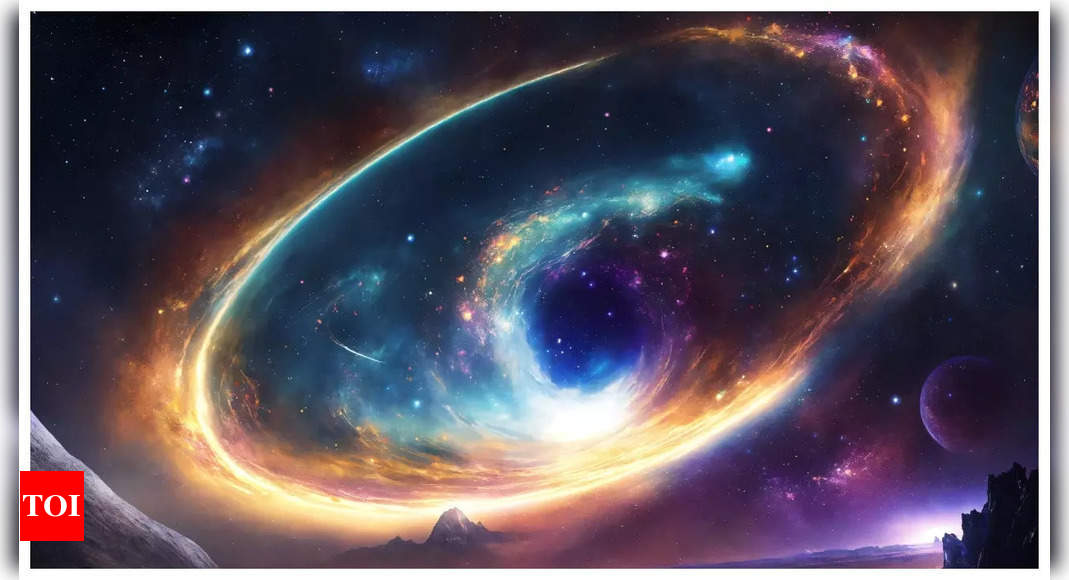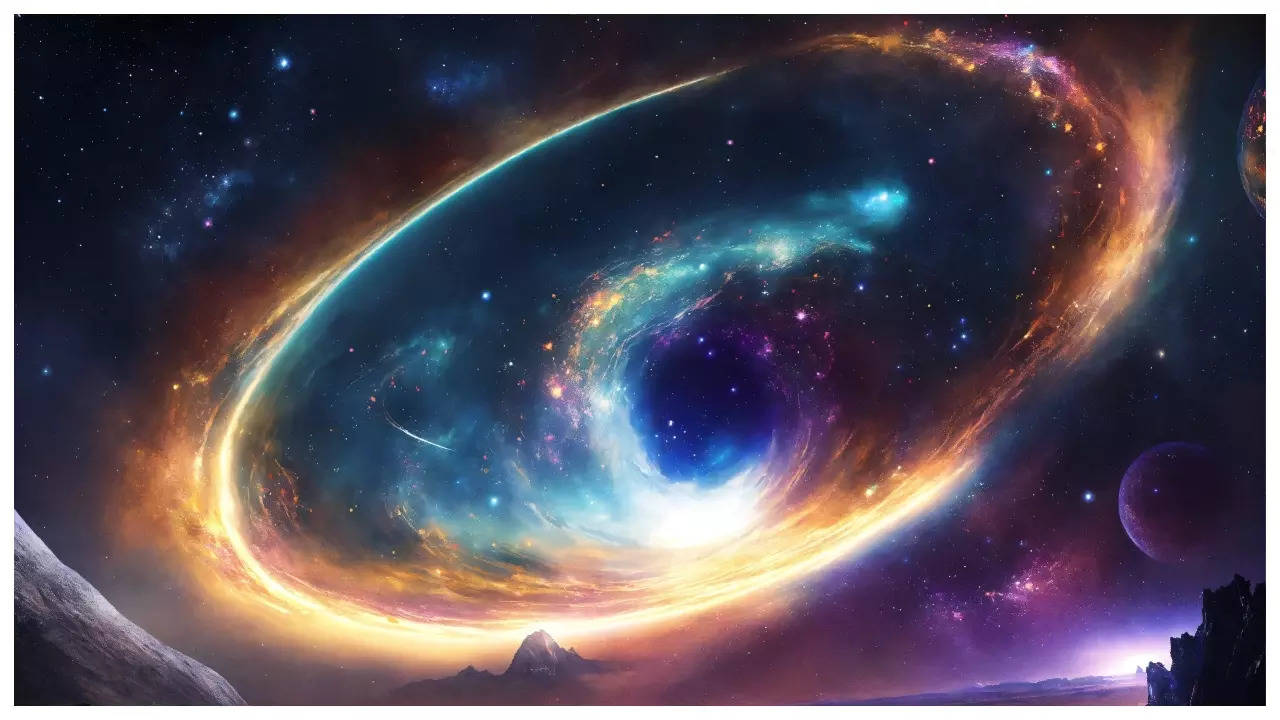NEW DELHI: Nasa’s James Webb Space Telescope (JWST) has unveiled a behemoth of a galaxy in the nascent stages of the universe, which, by current cosmological theories, shouldn’t exist. This discovery presents a “significant challenge” to conventional cosmological models, assert the researchers involved in the study.
JWST primarily observes the universe in the infrared spectrum.This allows it to look further back in time than Hubble, capturing light from the earliest stars and galaxies formed after the Big Bang. Infrared observation is also less affected by dust obscuration, enabling clearer views of cosmic phenomena.
Tagged as ZF-UDS-7329, this galaxy boasts a star population surpassing that of the Milky Way, even though it materialized merely 800 million years after the birth of the universe, which spans 13.8 billion years. This scenario suggests that these stars were formed without the influence of dark matter, a fundamental element according to conventional galaxy formation models, a space.com report said.
This conundrum mirrors the shock induced by previous JWST findings, which spotlighted similarly colossal galaxies dating back to the universe’s infancy. Such discoveries are shaking the foundations of our comprehension of the universe’s initial material formation and may even challenge the core principles of cosmology. The findings were detailed in a study published on February 14 in the journal Nature.
“Encountering these gargantuan galaxies so soon in the universe’s history poses substantial hurdles for our established cosmological framework,” remarked study co-author Claudia Lagos, an associate professor of astronomy at the International Centre for Radio Astronomy Research. The issue lies in the fact that massive dark matter structures, deemed essential for the cohesion of early galaxies, had insufficient time to develop at this stage in the cosmic timeline.
The ability to peer back in time through Nasa’s JWST’s observations, which capture light from 11.5 billion years ago, has been pivotal in this discovery. Analysis of the light spectra from this distant galaxy’s stars indicates they originated about 13 billion years ago.
The timing of the first assemblies of star clusters into the galaxies recognized today remains uncertain. However, it was previously believed that this process commenced gradually within the universe’s initial few hundred million years post-Big Bang. According to prevailing theories, the universe’s infancy involved dark matter halos merging with gas to kickstart galaxy formation. Over 1 to 2 billion years, these nascent structures matured into dwarf galaxies, eventually merging to form larger galaxies.
Yet, the recent discovery challenges this narrative. ZF-UDS-7329 not only formed without the requisite dark matter accumulation but also experienced a rapid halt in star formation shortly after a prolific phase of stellar birth.
“This finding stretches the limits of our existing models on galaxy formation and evolution,” said Themiya Nanayakkara, a study co-author and astronomer at Swinburne University of Technology in Australia. The pressing questions now revolve around how such rapid formation occurred early in the universe and what unknown forces subsequently halted their star formation processes.
The research team plans to continue their quest for similar galaxies, which could further disrupt conventional theories of galaxy evolution.
JWST primarily observes the universe in the infrared spectrum.This allows it to look further back in time than Hubble, capturing light from the earliest stars and galaxies formed after the Big Bang. Infrared observation is also less affected by dust obscuration, enabling clearer views of cosmic phenomena.
Tagged as ZF-UDS-7329, this galaxy boasts a star population surpassing that of the Milky Way, even though it materialized merely 800 million years after the birth of the universe, which spans 13.8 billion years. This scenario suggests that these stars were formed without the influence of dark matter, a fundamental element according to conventional galaxy formation models, a space.com report said.
This conundrum mirrors the shock induced by previous JWST findings, which spotlighted similarly colossal galaxies dating back to the universe’s infancy. Such discoveries are shaking the foundations of our comprehension of the universe’s initial material formation and may even challenge the core principles of cosmology. The findings were detailed in a study published on February 14 in the journal Nature.
“Encountering these gargantuan galaxies so soon in the universe’s history poses substantial hurdles for our established cosmological framework,” remarked study co-author Claudia Lagos, an associate professor of astronomy at the International Centre for Radio Astronomy Research. The issue lies in the fact that massive dark matter structures, deemed essential for the cohesion of early galaxies, had insufficient time to develop at this stage in the cosmic timeline.
The ability to peer back in time through Nasa’s JWST’s observations, which capture light from 11.5 billion years ago, has been pivotal in this discovery. Analysis of the light spectra from this distant galaxy’s stars indicates they originated about 13 billion years ago.
The timing of the first assemblies of star clusters into the galaxies recognized today remains uncertain. However, it was previously believed that this process commenced gradually within the universe’s initial few hundred million years post-Big Bang. According to prevailing theories, the universe’s infancy involved dark matter halos merging with gas to kickstart galaxy formation. Over 1 to 2 billion years, these nascent structures matured into dwarf galaxies, eventually merging to form larger galaxies.
Yet, the recent discovery challenges this narrative. ZF-UDS-7329 not only formed without the requisite dark matter accumulation but also experienced a rapid halt in star formation shortly after a prolific phase of stellar birth.
“This finding stretches the limits of our existing models on galaxy formation and evolution,” said Themiya Nanayakkara, a study co-author and astronomer at Swinburne University of Technology in Australia. The pressing questions now revolve around how such rapid formation occurred early in the universe and what unknown forces subsequently halted their star formation processes.
The research team plans to continue their quest for similar galaxies, which could further disrupt conventional theories of galaxy evolution.

